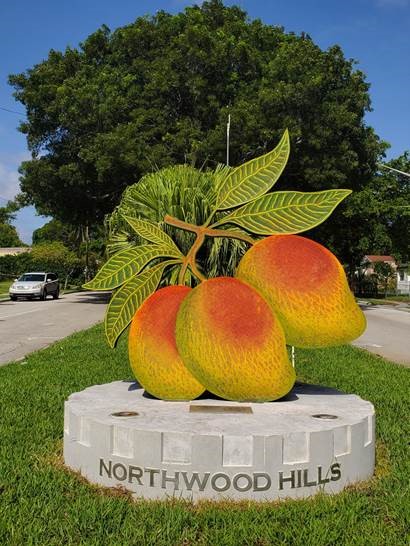WEST PALM BEACH, FLA (October 6, 2020) – The City of West Palm Beach Art in Public Places (AiPP) program has recently completed the twin installation “Mango Moiré,” located on 36th Street and Greenwood Avenue, and 36th Street and Windsor Avenue. These two new sculptures mark the entrances to the City’s Northwood Hills Historic District, located in the area between 45th St. and 25th St., and Australian Ave. and Greenwood Ave. “Mango Moiré” pays homage to the history of the neighborhood, which was established in 1925. The sculptures, atop a concrete pedestal, depict a cluster of colorful mangos still on the branch. The mango is significant to this neighborhood’s almost 100-year history.

“Mango Moiré” pays homage to Northwood Hills’ notable history
At the request of residents, Tucson, Arizona artists Simon Donovan and Ben Olmstead created the display from water-cut stainless steel and high-tech paints.
“After recent improvements to 36th Street, residents asked for a new sign to mark the entry to their neighborhood,” said Sybille Welter, Administrator of Public Art and Culture for the City of West Palm Beach. “What was created is a nod to the past while forming a beautiful gateway into this community.”
Northwood Hills has the unique distinction of being home to the very first mango tree successfully grown in the United States. The sweet, colorful fruit is not native to South Florida. It first arrived in the 1889, as part of an effort to grow a crop in Florida’s hot climate. Rev. Elbridge Gale, a retired professor from Kansas State Agricultural College who had moved to the area, was the first to successfully grow the tree in the United States. The tree was bearing fruit by 1896 in a lot that would eventually become a homestead in Northwood Hills. The fruit was so popular that nearly every new home in the area had mango trees in the yard.
When first established, the neighborhood was envisioned as an area with sprawling, wooded estates. A famous landmark is a large, Mizner-style home on Eastview Street, which was called “The Castle” because of its distinctive balcony which resembled a castle turret. A symbolic copy of the home’s turret is incorporated into the sculpture’s base.
“Mango Moiré” is the second AIPP installation in Northwood Hills. The other, “Deep Thought,” is a sculpture located in Sullivan Park, at 31st Street and Windsor Avenue.
The West Palm Beach Art in Public Places (AiPP) program seeks to create public art that encourages artistic exploration, infuses creativity into the City's diverse neighborhoods, and celebrates the City's historical richness and embraces art as an integral part of everyday life.
AiPP projects are funded, thanks to a 2014 ordinance requiring private developers to contribute to public art, by commissioning artwork on their site or contributing to the Public Art Fund, with the understanding that, by doing so, they contribute to the vitality and desirability of the City. The Public Art Fund, which is separate from the City’s General Fund, can be used for only the selection, commissioning, acquisition, installation, and maintenance of public art. The Ordinance allows for a broad spectrum of artworks in our City. The proposed artworks and location are reviewed by the AiPP Committee for recommendation to the City Commission for final approval.
To learn more about the AiPP program, visit the City Website at http://www.wpb.org/aipp or call Sybille Welter, Administrator of Public Art and Culture at (561) 822-1521/
For information about the City of West Palm Beach, please visit: https://www.wpb.org/.